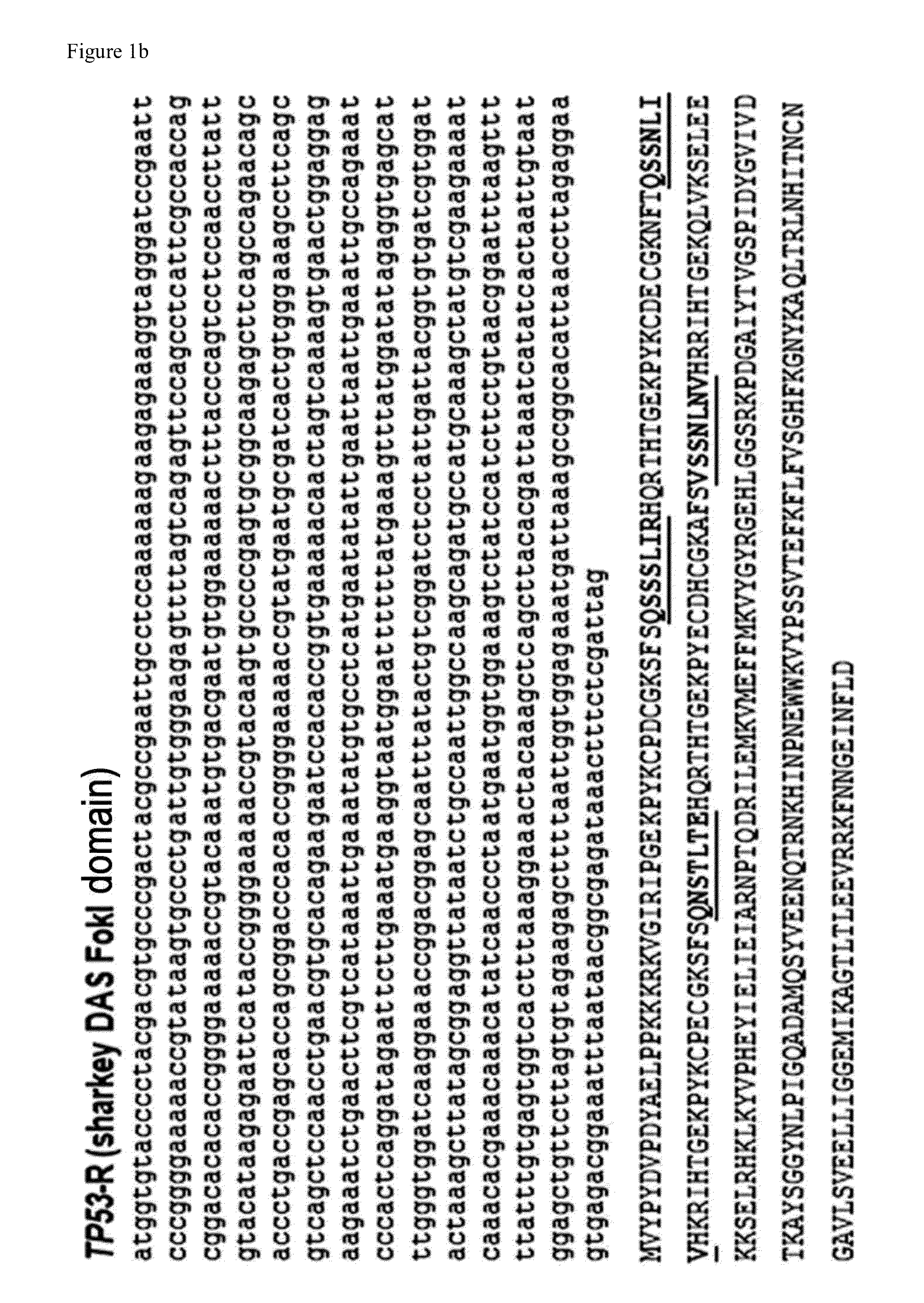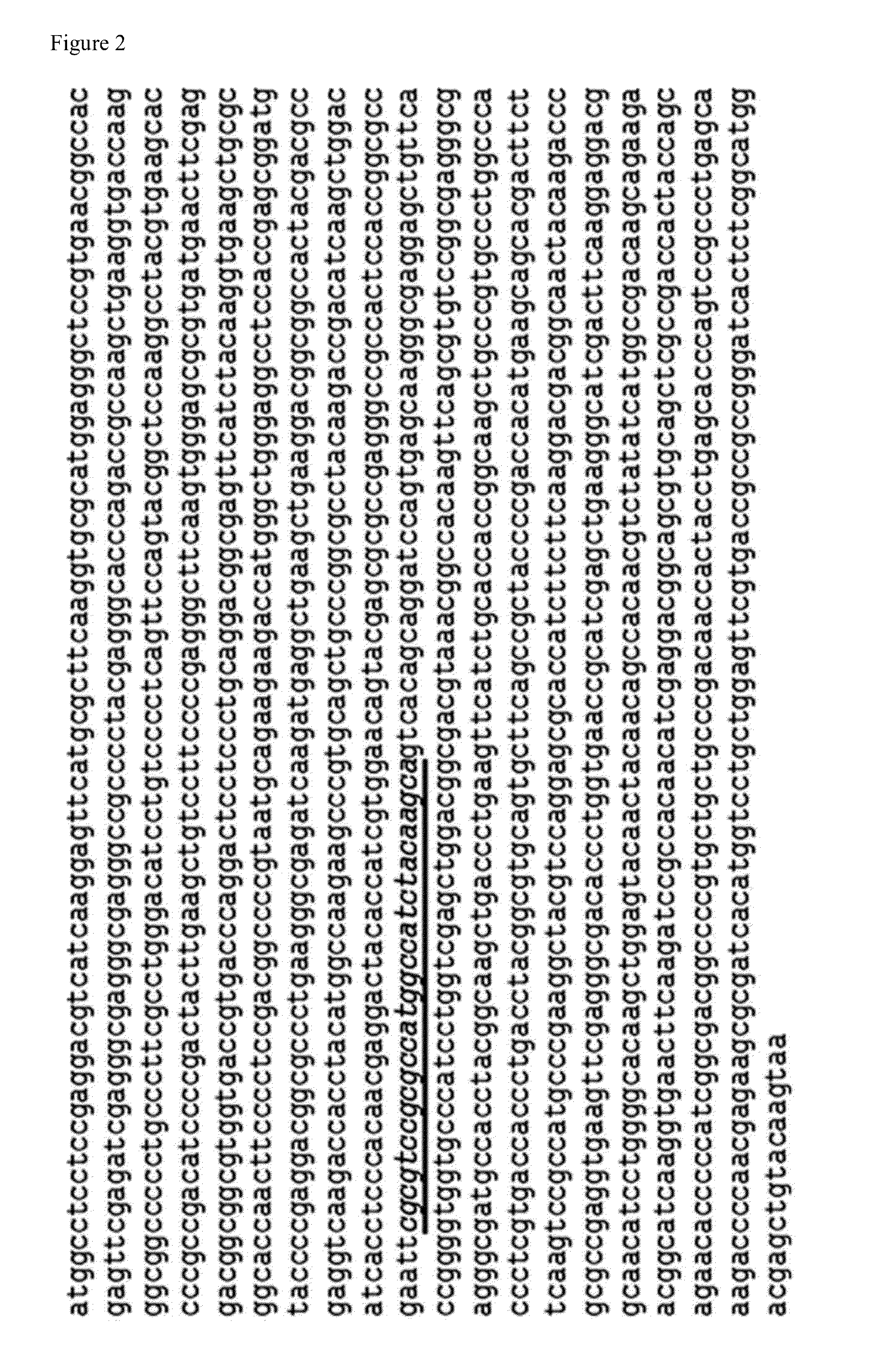Method for concentrating cells that are genetically altered by nucleases
a technology of nucleases and cells, applied in the field of reporter constructs, can solve the problems of high cost, difficult to isolate mutant cells, and inability to apply synthetic nucleases in gene therapy and basic research, and achieve the effect of efficient us
- Summary
- Abstract
- Description
- Claims
- Application Information
AI Technical Summary
Benefits of technology
Problems solved by technology
Method used
Image
Examples
example 1
Preparation of Reporter Construct and Sorting of the Cells Whose Genes are Modified by Synthetic Nuclease, by Using the Same
[0197]A target sequence for a synthetic nuclease was inserted in between the DNA sequences encoding monomeric red fluorescent protein (mRFP) and enhanced green fluorescent protein (eGFP) in the reporter plasmid encoding mRFP and eGFP, such that eGFP sequence would be out of frame with mRFP sequence. A stop codon was inserted upstream of eGFP sequence (see FIG. 3(a)).
[0198]After transfecting HEK293 cells with the reporter plasmid, the transfected cells were sorted by flow cytometry. As a result, it was observed that mRFP was expressed by CMV promoter, but a functional eGFP was not expressed since it was out of frame with the promoter when the synthetic nuclease was not active. If DSB is generated at a target sequence by synthetic nuclease, the damage of DNA can be repaired by NHEJ, however this causes a frame-shift mutation. Such mutation allows eGFP to be in fr...
example 2
Enrichment and Sorting of the Cells Whose Genes are Modified by TP53 Gene-Targeting ZFN
[0202]A plasmid encoding a ZFN pair which targets a human TP53 gene and a reporter plasmid comprising a nuclease target sequence were co-transfected into HEK293 cells. As a control, HEK293 cells were transfected with a reporter plasmid or a ZFN plasmid alone.
[0203]After 24 hours of transfection, a majority of the cells appeared as RFP+, while GFP+ cells were rarely detected. However, the number of GFP+ cells gradually increased after 3 days, and the GFP+ cells were all RFP+ (FIG. 5). After 72 hours of transfection, a flow cytometry was performed. As a result, it was observed that about 16% of the cells were RFP+GFP−, and about 5% of the cells were RFP+GFP+ (FIG. 6a).
[0204]The RFP+GFP+ cell population was sorted by flow cytometry. In order to examine the mutation rate induced by nuclease, genomic DNA was isolated and analyzed.
[0205]As a result of performing a T7 endonuclease I (T7E1) assay on the g...
example 3
Enrichment and Sorting of the Cells Whose Genes are Modified by ZFN that Targets CCR5 Gene
[0208]In order to examine whether the reporter system of the present invention can be applied to enrich the cells whose genes are modified by other ZFNs, ZFN-224 and Z891 which target different sequences in the human CCR5 gene were used.
[0209]After 72 hours of transfecting the cells with ZFN-224 and performing flow cytometry, it was observed that 23% of the cells appeared as RFP+GFP+ (FIG. 7a). Also, as a result of T7E1 assay, the sorted RFP+GFP+ cell population showed a mutation rate of 69%, and the unsorted cells, i.e., RFP−GFP− and RFP+GFP− cells showed a mutation rate of 12 to 16%. That is, the sorted RFP+GFP+ cells had about 5.8 times higher mutation rate than the unsorted cells (FIG. 7b).
[0210]In addition, as a result of fPCR analysis, it was confirmed that the sorted RFP+GFP+ cell population showed about 17 times higher amount of mutant cell enriched compared to the unsorted cells, i.e.,...
PUM
| Property | Measurement | Unit |
|---|---|---|
| temperature | aaaaa | aaaaa |
| antibiotic resistance | aaaaa | aaaaa |
| fluorescence | aaaaa | aaaaa |
Abstract
Description
Claims
Application Information
 Login to View More
Login to View More - R&D
- Intellectual Property
- Life Sciences
- Materials
- Tech Scout
- Unparalleled Data Quality
- Higher Quality Content
- 60% Fewer Hallucinations
Browse by: Latest US Patents, China's latest patents, Technical Efficacy Thesaurus, Application Domain, Technology Topic, Popular Technical Reports.
© 2025 PatSnap. All rights reserved.Legal|Privacy policy|Modern Slavery Act Transparency Statement|Sitemap|About US| Contact US: help@patsnap.com



